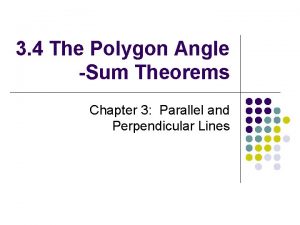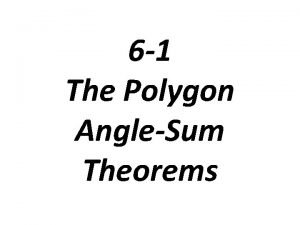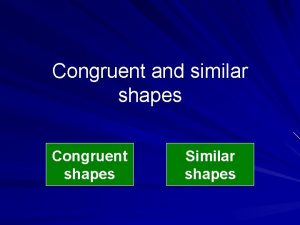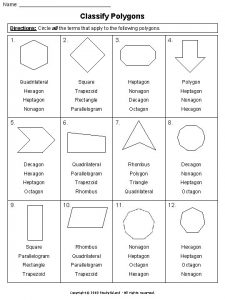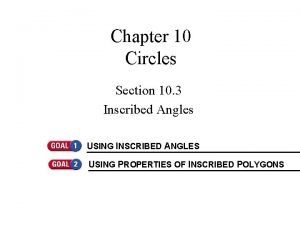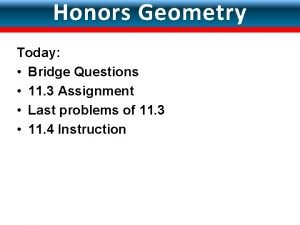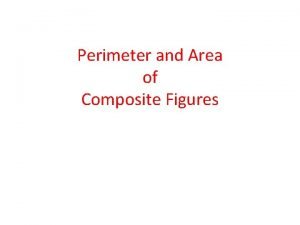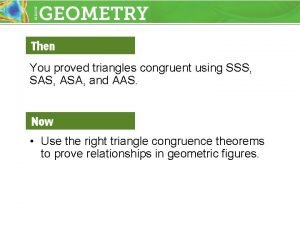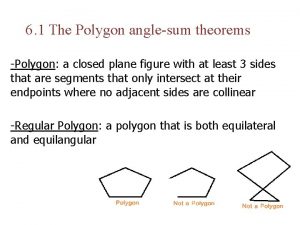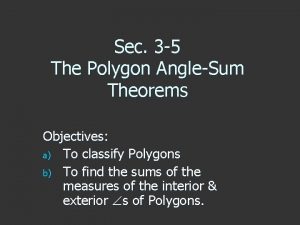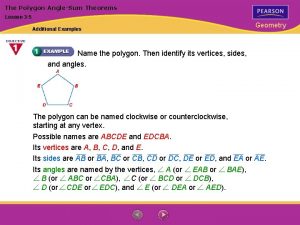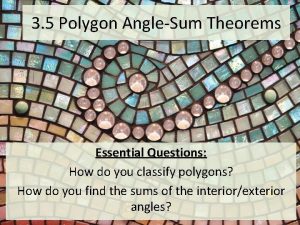Section 3 4 Polygon AngleSum Theorems Name Polygons














- Slides: 14

Section 3 -4 Polygon Angle-Sum. Theorems • Name Polygons • Calculate Interior Angles • Calculate Exterior Angles • Understand Diagonals

The Basics. . . Definition: A polygon is a closed plane figure with at least three sides that are segments. The sides intersect only at their endpoints, and no adjacent sides are collinear. Polygons Not Polygons

Naming Polygons Start at any vertex and list the vertices consecutively in a clockwise or counterclockwise direction. D E I N A DIANED ANEDIA EDIAN DENAID NAIDEN IDENA

Definition: A diagonal of a polygon is a segment that connects two nonconsecutive vertices.

The Basics. . . Definition: A convex polygon has all diagonals on the interior of the polygon. Definition: A concave polygon has a diagonal on the exterior of the polygon. Convex Concave

Naming Polygons # Sides 3 4 5 6 7 8 9 10 12 n Polygon triangle quadrilateral pentagon hexagon heptagon octagon nonagon decagon dodecagon n-gon


Real-Life Connections H C C H C H Benzene H

Apply What You Already Know: Theorem: The sum of the measures of the three angles in a triangle is 180 degrees. How About a Quadrilateral? . . . What is the sum of the angles? Explain your answer?

Polygons and Interior Angles Investigation Part I Theorem: The sum Si of the measures of the angles of a polygon with n sides is given by the formula: Si = (n – 2)180. Huh? • The polygon is divided into triangles. • The number of triangles is always two less than the number of polygon sides. • There are 180 in each triangle.

Polygons and Exterior Angles Investigation Part II Theorem: If one exterior angle is taken at each vertex, the sum Se of the measures of the exterior angles of a polygon is given by the formula Se = 360 Huh? exterior angle If you cut out each exterior angle and arranged the vertices on top of one another they would form a circle of sorts.

More About Interior Angles Investigation Part III 180 n – 360 = 180(n – 2) Huh? If you add all the angles of each triangle, then you include all the angles that go completely around the selected point. Hence, you need to subtract 360!

Diagonals of Polygons Investigation Part III Theorem: The number, d, of diagonals that can be drawn in a polygon of n sides is given by the formula: Huh? From each of the n vertices you can draw n – 3 diagonals. Thus, there are n(n-3) diagonals total. But, by this method, each diagonal is drawn twice, so you must divide by 2.

Regular Polygons Definition: A regular polygon is a polygon that is both equilateral and equiangular. Theorem: The measure E of each exterior angle of an equiangular polygon of n sides is given by the formula exterior angle
 6-1 practice the polygon angle-sum theorems
6-1 practice the polygon angle-sum theorems 3-5 the polygon angle-sum theorems
3-5 the polygon angle-sum theorems 6-1 the polygon angle-sum theorems
6-1 the polygon angle-sum theorems Which of these shapes is congruent to the given shape?
Which of these shapes is congruent to the given shape? Not a polygon
Not a polygon Name three line segments
Name three line segments Polygons
Polygons Section 10 topic 3 inscribed polygons in a circle
Section 10 topic 3 inscribed polygons in a circle Geometry section 11-4 areas of regular polygons answers
Geometry section 11-4 areas of regular polygons answers Names of polygons
Names of polygons Polygons formula
Polygons formula A convex heptagon
A convex heptagon Perimeter of composite shapes
Perimeter of composite shapes Congruent triangles sss sas asa aas
Congruent triangles sss sas asa aas Trigonometry ratios (a) maze answer key
Trigonometry ratios (a) maze answer key

